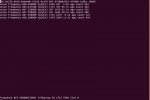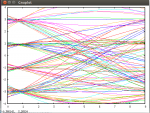That's a pretty big fine tune adjustment (3500) that you're running in the screenshot. You can tweak the ppm correction (-q xx) by 4 to achieve the same thing (4 x 867.95 = 3472).
If anything, you want to move the tune line just a hair to the left, but since you're using C4FM modulation, you might be better off switching to plot "4" (datascope) and tune so the lines converge at the 3,1,-1,-3 levels on the y axis.
Logging can be increased a little by adding "-v 1" or increased a lot by adding "-v 10". You might try increasing it to level 1 and copying the output here in case there is anything interesting popping up.
Could you post your trunk.tsv please.
Do you have any entries for whitelist and blacklist?
On the rare occasions when you do get audio, is it always the same tgid?
Is this a Phase II or mixed Phase I/II system?
Have you tried reconfiguring for cqpsk? It's possible the system is actually cqpsk modulated regardless of what it says in RRDB.
Below is the "datascope" mode picture when the offset is 0, the lines are converging exactly where you mentioned.
I think that if the line are converging at 3,1,-1,-3 where the offset is 0, it's a good indication that the tunning is very good, isn't it?
I have used the "-v 1" argument.
This is the beginning of the "stderr.2" file during OP25 run with "-v 1" argument.
It's indeed different compare to previous one without the "-v xxx" argument.
gr-osmosdr 0.1.4 (0.1.4) gnuradio 3.7.9
built-in source types: file osmosdr fcd rtl rtl_tcp uhd miri hackrf bladerf rfspace airspy redpitaya
Using device #0 Realtek RTL2838UHIDIR SN: 00000001
Found Rafael Micro R820T tuner
[R82XX] PLL not locked!
Exact sample rate is: 1444000.010137 Hz
[R82XX] PLL not locked!
Project 25 IMBE Encoder/Decoder Fixed-Point implementation
Developed by Pavel Yazev E-mail:
pyazev@gmail.com
Version 1.0 (c) Copyright 2009
This program comes with ABSOLUTELY NO WARRANTY.
This is free software, and you are welcome to redistribute it
under certain conditions; see the file ``LICENSE'' for details.
op25_udp:

pen_socket(): enabled udp host(127.0.0.1), wireshark(23456), audio(23456)
p25_frame_assembler_impl: do_imbe[1], do_output[0], do_audio_output[1], do_phase2_tdma[1]
audio device: default
1508703148.595917 voice update: tg(2433), freq(866137500), slot(1)
1508703150.319173 p25p1_fdma::rx_sym() timeout
1508703150.319718 voice timeout
1508703150.957777 voice update: tg(27005), freq(868312500), slot(1)
1508703152.679091 p25p1_fdma::rx_sym() timeout
1508703152.680305 voice timeout
1508703153.405679 voice update: tg(2433), freq(866137500), slot(1)
1508703155.041767 p25p1_fdma::rx_sym() timeout
1508703155.042334 voice timeout
1508703155.585321 voice update: tg(2433), freq(866137500), slot(1)
1508703157.219265 p25p1_fdma::rx_sym() timeout
1508703157.219533 voice timeout
1508703157.763066 voice update: tg(2433), freq(866137500), slot(1)
1508703159.486551 p25p1_fdma::rx_sym() timeout
1508703159.486985 voice timeout
1508703160.125662 voice update: tg(2469), freq(868312500), slot(0)
1508703161.846599 p25p1_fdma::rx_sym() timeout
1508703161.846730 voice timeout
1508703162.301936 voice update: tg(61239), freq(868312500), slot(1)
1508703164.025373 p25p1_fdma::rx_sym() timeout
1508703164.026376 voice timeout
Before using "-v 1", it just kept saying timeouts without any of these voice updates or voice timeouts messages.
Still no sound though.
Below is also the the "trunk.tsv" picture.
As you can see, no entries for whitelist and blacklist.
On the rare occasions where I do get audio, it's not the same tgid.
It's a mixed Phase I/II system - control channels phase I and voice channels phase 2.
The system uses "C4FM" for sure.
A friend of mine is successfully monitoring it, but uses the old version of op25 (the one with scope.py and not rx.py).







